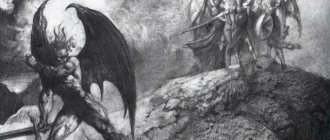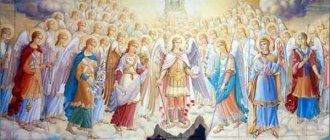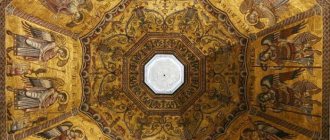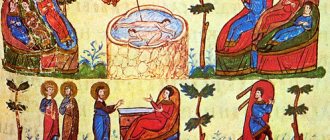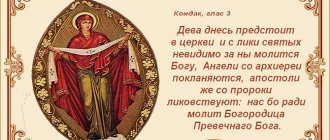(Or) angel LORDER
(Hebrew: מַלְאַךְ יְהוָה malakh
"messenger of Yahweh") is an entity that appears repeatedly in the Tanakh (Old Testament) on behalf of the God of Israel.
Period, term malakh YHWH
, which appears 65 times in the text of the Hebrew Bible, can be translated "angel of the Lord" or "angel of the Lord." The King James Version is usually translated as "angel LORDER"; less often as "angel LORDER".[1] The Septuagint (LXX) sometimes uses ἄγγελος Κυρίου (angel of the Lord), sometimes ὁ ἄγγελος Κυρίου (angel of the Lord): in Genesis 16:7–11 it gives first the form without the Greek article, and then throughout subsequent references in the article ,[2] as in the anaphoric use of an article.[3]
A closely related term is “angel of God” ( Malakh Elohim
), mentioned 12 times (2 of them in the plural). Another related expression, the Angel of the Presence occurs only once (Isaiah 63:9).
The New Testament uses the term "Angel of the Lord" (ἄγγελος Κυρίου) several times, in one case (Luke 1:11–19), identifying him with Gabriel.
Hebrew Bible
Angel of Yahweh
Examples of the use of the Hebrew term מַלְאַךְ יְהוָה can be found in the following verses, given here in the King James Version:
- Genesis 16:7–14. The Angel of the Lord appears to Hagar. The angel speaks as God in the first person, and Verse 13 Hagar identifies "LORDER who spoke to her, "as "You, God, see me."
- Genesis 22:11–15. The Angel of the Lord appears to Abraham and refers to God in the first person.
- Exodus 3:2–4. The angel of the Lord appears to Moses in the flames in verse 2, and God speaks to Moses from the flames in verse 4.
- Numbers 22: 22–38. The Angel of the Lord meets the prophet Balaam on the road. In verse 38, Balaam identifies the angel who spoke to him as delivering the word of God.
- Judges 2:1–3. The Angel of the Lord appears to Israel.
- Judges 6:11–23. The Angel of the Lord appears to Gideon, and in verse 22 Gideon fears for his life because he has seen the Angel of the Lord face to face.
- Judges 13:3–22. The angel of the Lord appears to Manoah and his wife and in verse 16 tells them to bring to the Lord if they are to offer a sacrifice (“And the Angel LORDER said to Manoah […] if you would offer a burnt offering, you must offer it LORDER. For Manoah did not know that he is an angel LORDER."). Manoah later thought that he and his wife would die because they had "seen God."
- Zechariah 1:12. The Angel of the Lord begs the Lord to have mercy on Jerusalem and the cities of Judea.
- Zechariah 3:4. The angel of the Lord takes away the sin of the high priest Joshua.
The Greek translation of the Old Testament known as the Septuagint[4] translates the Hebrew phrase מַלְאַךְ יְהוָה as ἄγγελος Κυρίου, “angel of the Lord” or as γγελος Κυρίο υ, "angel of the Lord." "Because of the Hebrew idiom, it can mean no more than 'angel of God,' and the Septuagint translates the word with or without the article as desired."[5]
In the KJV and NKJV, capitalize "Angel" in Old Testament references to " that
Angel of the Lord ", and lowercase letters "angel" in Old Testament references to "
an
angel of the Lord" (and in references to the New Testament). Most versions, including NASB, RSV, ESV, etc., do not capitalize the word “angel” when referring to the word “angel of the Lord.”
Angel Elohim
The term "angel of God" (Heb. Malakh Elohim
) occurs 12 times (2 of which are in the plural). Below are examples:
- Genesis 31:11. An angel of God calls to Jacob in a dream and tells him, “I am the God of Bethel.”
- Exodus 14:19. An angel of God leads the camp of Israel and also follows them with a pillar of fire.
- Judges 13:9 An angel of God approached Manoah's wife after the Lord heard Manoah.
David is depicted interceding for the people to end the plague (1 Chronicles 21) in this 1860 engraving by Julius Schnorr von Carolsfeld.
Additionally, there are references to God "sending an angel", examples of which are given below:
- Exodus 23:20–21. LORDER says that he will send an Angel before the Israelites, and warns them to obey the voice of the Angel, and that the Angel "will not forgive wrongdoing" because LORDER's "name is in it."
- Exodus 33:2. God says that he will send an angel before the Israelites, and that God will drive out the Canaanites, Amorites, Hittites, Perizzites, Hivites, and Jebusites.
- Numbers 20:16. LORDER sent an angel and led the people of Israel out of Egypt.
- 1 Chronicles 21:15. God sent an angel to destroy Jerusalem, but then repented and told the angel to stop his hand.
- 2 Chronicles 32:21. LORDER sent an angel who destroyed all the brave warriors, leaders and military commanders in the camp of the king of Assyria.
God may have created angels on day 3 of creation, although we don't know for sure
When the celestial beings arose, we do not know. The Holy Scriptures do not answer this. But a number of interpreters who are skeptical about angels believe that their image is simply an illustration of different luminaries. That is, the countless army of God is the stars.
"while the morning stars sang together, and all the sons of God shouted for joy"
(Job 38:7)
Astronomical theories are generally quite popular in relation to the Bible. There are many enthusiasts who say that Jesus is the Sun, the Antichrist is the not yet discovered second star of the solar system, and the entire Bible is a guide to the galaxy.
Angels are often associated with the stars, and astronomical symbolism is sought in the Bible.
Orthodoxy does not take such theories seriously, for the Bible often makes it clear that angels are beings endowed with will and capable of interacting with people. What kind of stars can we even talk about?
In addition, if according to some versions, the stars are angels, then according to others, the stars are evil spirits, for what else could black creatures with glowing eyes be if not an illustration of the night sky?
But if we at least partially accept the “cosmic” version for a second, then the angels were created on the 3rd day of creation:
“And God said, Let there be lights in the expanse of the heaven to separate the day from the night, and for signs, and for seasons, and for days, and for years; and let them be lamps in the firmament of the heaven to give light on the earth.
And so it became. And God created two great lights: the greater light to rule the day, and the lesser light to rule the night, and the stars; and God set them in the firmament of the heaven to give light on the earth.”
(Gen. 1:14–17)
It is also a popular opinion that angels arose even before the creation of the world, because they are transcendental to it. Ufologists see angels as aliens. But the truth is one: it is impossible to say anything definite about angels.
New Testament
in the New Testament the Greek phrase ἄγγελος Κυρίου ( Aggelos Kuriou
- "Angel of the Lord") found in Matthew 1:20, 1:24, 2:13, 2:19, 28:2;
Luke 1:11, 2:9; John 5:4; Acts 5:19, 8:26, 12:7, and 12:23. English translations render this expression as "angel of the Lord" or "angel of the Lord".[6] The references in Acts 12:11 and Revelation 22:6 to the words "his angel" (angel of the Lord) can also be understood to refer to either
the angel of the Lord or
an
angel of the Lord.
The Angel of the Lord mentioned in Luke 1:11 calls himself Gabriel in Luke 1:19.
The angelic world has been compared to heaven, but no one has described it
We don’t know what the angelic world looks like. Since ancient times, people have contrasted heaven and earth. But the point is not that there are angels with harps sitting somewhere on a cloud. It’s just that heaven is infinitely distant from man, this is the greatest gulf to illustrate the distance between the carnal and the spiritual.
The visions of the prophets also cannot tell us anything about the world of angels. They are largely symbolic and subjective. When Ezekiel describes thrones, cherubim, and the glory of God, we should be careful with these images so as not to be deceived by them.
This beautiful angel is actually the goddess Victoria, made of bronze in the age of Jesus Christ. This is where our idea of the appearance of angels “grows” (Brescia, Santa Giulia Municipal Museum.). Photo: ancientrome.ru
The way we imagine angels today is a product of popular culture. It was antiquity, with the help of Nike (Victoria) and Cupid (Cupid, Eros), that created the familiar winged appearance of an angel.
But all these are just symbols. How far they are from reality, only God knows.
By leaving a comment, you accept the user agreement
Interpretations
Most appearances of the "angel of the Lord" leave the reader wondering whether it was the angel or YHWH who appeared. Apart from the view that "an angel of the Lord is just an angel",[7] a wide range of solutions have been proposed, such as turning the angel into an earthly manifestation (avatar) of the God of Israel or of Christ.
in Catholic Encyclopedia
(1907) Hugh Pope writes: “The earlier Fathers, from the letter of the Septuagint, asserted that it was God Himself who appeared as the Giver of the Law to Moses. It was not then unnatural for Tertullian […] to consider such manifestations in the light of the preludes to the Incarnation, and most of the Eastern Fathers followed the same line of thought." The Pope quotes Theodoret's view that this angel was probably Christ, "the Only Begotten Son, the Angel of the great Council," and contrasts Theodoret's view with the opposing view of the Latin Fathers. Jerome, Augustine, and Gregory the Great that it was nothing more than an angel, a view which, in his words, "was destined to live in the church, and the scholastics reduced it to a system." As a representative of this view, he quotes Augustine, who stated that "an angel is rightly called an angel if we consider him to be himself, but he is equally rightly called 'Lord' because God dwells in him." However, he points out that the opposite view was also supported within the Catholic Church.[5]
The appearance of the "angel of the Lord" is in fact often presented as a theophany, the appearance of YHWH himself rather than an individual acting on his behalf.[8] In Genesis 31:11–13, the "Angel of God" says, "I am the God of Bethel." In Exodus 3:2–6, the "Angel of Yahweh" (מלאך יהוה) appeared to Moses in a flame of fire, and then "Yahweh" (יהוה) said to him, "I am the God of your father." Compare also Genesis 22:11; Judges 6:11–22. Sometimes the angel of the Lord speaks in a way that assumes authority over previous promises (see Gen. 16:11 and 21:17). According to the New American Bible, the visual form in which God appeared and spoke to people is indifferently referred to in some Old Testament texts as either an angel of God or God himself.[9]
Another interpretation is based on the way in which the ancient representatives, after the opening phrase, used the grammatical first person in declaring the point of view of the one they represent.[10]
Another proposal is the interpolation theory of Samuel A. Meyer,[11] who argues that originally stories in which there is ambiguity between Yahweh and an "angel of Yahweh" were written with Yahweh himself delivering the message. Later scribes inserted the term Malakh
before the divine name to change the narratives to meet the standards of a changing theology that more strongly emphasizes a transcendent God.
If the term Malakh
is removed from these passages, the remaining story exactly follows the "default" format in Near Eastern literature, in which the deity appears directly to people, without intermediaries.
The addition of Malakh
does not require a change in the form of the verbs associated with it, since both
Malakh
and a deity such as Yahweh or Elohim have a masculine grammatical gender, and the noun before which
Malakh
is introduced remains unchanged at the consonantal level.
On the other hand, removing the word Malakh
from a narrative usually makes it more coherent and appropriate to its Ancient Near Eastern literary context.[12]
Although Wojciech Kosior supports this theory of interpolation, he mentions some unresolved difficulties associated with it: the large number of similar theophanies in which the word Malakh
has
no
was added to the names Yahweh and Elohim and the fact that it is never associated with names such as El-Elyon, El-Shaddai or El-Rohe, which are worshiped by biblical Jews.[13]
Possible Christianity
Further information: Christophany and Preexistence of Christ
Early Church Fathers, such as Justin Martyr, identified the angel of the Lord as the pre-incarnate Christ[14] whose appearance, i.e. Christophany, recorded in the Hebrew Bible. Regarding the reason why some early Christians considered Jesus to be the angel of the Lord, Susan Garrett says:
[The logic underlying] the reading of Jesus into the Angel of the Lord narrative went deeper. Many Jews before and during the time of Jesus were deeply interested in angels. Some understood the angel of the Lord as a being completely separate from God—a kind of angelic vizier or right-handed angel who served as the head of the heavenly host and performed other important functions, including mediating between God and people. Additionally, some Jews commonly used the language of Scripture to describe the angel of the Lord and used it to describe certain attributes of God, including His word
,
glory
,
wisdom
,
spirit
,
power
, and
name
- almost as if these aspects of the Godhead were themselves independent angels.
In other words, completely apart from Christianity, the ancient Jews talked about God. word
,
glory
, and so on in expressions very reminiscent of the Angel of the Lord. So, when early Christian authors such as Justin Martyr associated Jesus with the word of God, and that word in turn with the angel of the Lord, they were not inventing so much from scratch as adding a new layer to established ways of reading Scripture.[15]
The Hellenistic Jewish philosopher Philo identified the angel of the Lord (singular) with Logos.[16][17]
In Baker's Evangelical Dictionary of Biblical Theology
Louis Goldberg writes: “The functions of the angel of the Lord in the Old Testament prefigure the reconciling ministry of Jesus. There is no mention of the angel of the Lord in the New Testament; this man is the Messiah himself.”[18]
On the other hand, Knoefel Staton says: “The idea that this angel was Christ is unlikely for many reasons, including the following: 1) God never said to any angel (including the “angel of the Lord”): “You are mine.” son '(Heb. 1:5) ... ";[19] Ben Witherington says: "The angel of the Lord is just an angel. […] The Divine Son of God […] was not a mere angel of the Lord, nor did he manifest himself in any observable form. before the Incarnation ".[20]
Jehovah's Witnesses Teach that the angel who led the Israelites to their promised land and would not forgive the crime because the name of God was on him (Exodus 23:20–21) was the "Firstborn Son of God", the pre-existent Christ, also called the archangel Michael, the prince people of Israel, mentioned in Daniel 10:21, the Firstborn is called the “Son of God” because he was created with qualities similar to those of his Father.[21][22]
The Holy Fathers do not know whether angels are incorporeal and invisible
One of the difficult questions is: are angels disembodied spirits or material beings? The Holy Fathers of the Church did not come to a consensus. It is tempting to believe that an angel is an invisible and disembodied spirit, but the Bible tells a different story: God’s messengers are tangible, eat and drink, and look exactly like people.
Even God himself looks like a man, if “created in the image and likeness” is taken literally (however, the version about spiritual likeness is much more beautiful).
Some believe that an angel can become tangible, others believe that a particle of materiality is an obligatory feature of even a spiritual creature. This is what St. Macarius the Great says:
“Every creature: both angel and soul,
and the demon by his own nature is a body,
because, although they are refined,
however, in its essence,
by its distinctive features and image,
According to the refinement of their nature, they are subtle bodies,
whereas...our body is essentially fat.”
Macarius the Great
Reverend
And here is what John of Damascus writes:
“As for the Angel, he,
although it is not physically contained in a place like this,
to get an image and a certain look,
however, it is said about him
that he is in the place by spiritual presence and action, as is proper to his nature,
and is not present everywhere, but where it acts,
there it is spiritually limited,
because it cannot act at the same time in different places.”
John of Damascus
theologian
Recommendations
- Judges 2:1; 6:11, 22; 13:16, 21
- Genesis 16:7–11
- “An anaphoric clause is a clause that denotes a previous mention. The first mention of the essential is usually anarthrotic because it is simply introduced. But in subsequent references to it, the article is used, since the article now points to the essential thing previously mentioned” (Berean Christian Bible Resources: Greek Article and Others).
- Modern critical editions of the Septuagint are based on the Codices. Vaticanus, Sinaiticus, and Alexandrinus are the oldest complete texts currently in existence, taking into account the few older fragments that have been discovered (see Septuagint Manuscripts).
- ^ a b
Dad, Hugh.
"Angels" in The Catholic Encyclopedia
. Vol. 1. New York: Robert Appleton Company, 1907, accessed July 9, 2022. - For example, Matthew 1:20
- Ben Witherington, The Living Word of God
(Baylor University Press 2007 ISBN 978-1-60258-017-6), par. 224 - Douglas K. Stewart, Exodus
2006 p.109. "Now, however, God in the form of the Angel LORDER' (see excursion below, "Angel of the Lord") appeared to Moses in the epiphany of fire (see excursion below, "Epiphany of fire")" - New American Bible: Note on Exodus 3:2
- Kosior, Wojciech. “Angel in the Hebrew Bible from a statistical and hermeneutical point of view. Some remarks on the theory of interpolation." "Polish Journal of Biblical Research", Vol.
12, No. 1 (23), pp. 59-60 . Retrieved July 10, 2022. - Samuel Arthur Meyer (1999). K. van der Toorn; B. Becking; P. W. van der Horst (ed.). Dictionary of Deities and Demons
. Leiden – Boston – Cologne: Wm. B. Eerdmans Publishing. p.-59. Meyer interpolation. - Kosior, Wojciech. “Angel in the Hebrew Bible from a statistical and hermeneutical point of view. Some remarks on the theory of interpolation." "Polish Journal of Biblical Research", Vol.
12, No. 1 (23), pp. 60-61 . Retrieved November 22, 2013. - Kosior, p. 69
- Garrett, Susan R. (2008). No Ordinary Angel: Heavenly Spirits and Christian Claims about Jesus
.
Yale University Press. p.248, paragraph 28. ISBN 978-0-300-14095-8. Justin Martyr identified the Angel of the Lord with the pre-incarnate Christ; see Gieschen, Angelomorphic Christology
, 187-200;
Hannah, Michael and Christ
, 111-13;
on early angelomorphic Christology more generally, see Richard N. Longenecker, “Some Distinctive Early Christological Motifs,” New Testament Studies
14 (1967–68): 526–45;
Christopher Rowland, Christian Origins: An Account of the Setting and Character of the Most Important Messianic Sect of Judaism
(2nd ed.; London: SPCK, 2002), 32-36.
David Keck ( Angels and Angelology in the Middle Ages
[New York: Oxford University Press, 1998], 35) notes that in the early church the identification of the Angel of the Lord with Christ "became an essential element of anti-Jewish polemics." - Garrett, Susan R. (2008). No Ordinary Angel: Heavenly Spirits and Christian Claims about Jesus
. Yale University Press. pp. ISBN 978-0-300-14095-8. - Frederick Copleston, History of Philosophy
, Volume 1, Continuum, 2003, p. 460. - J. N. D. Kelly, Early Christian Doctrines
, 5th ed., HarperOne, 1978, p. eleven. - Angel of the Lord - Elwell, Walter A. - Evangelical Dictionary of Theology
. Retrieved April 9, 2012. - Knofel Staton, Angels
(College Publishing 2005 ISBN 978-0-89900-939-1), para. 211 - Ben Witherington, The Living Word of God
(Baylor University Press 2007 ISBN 978-1-60258-017-6), par. 224 - “Your Leader is One, Christ”—The Watchtower—Proclaiming Jehovah's Kingdom
—September 15, 2010, p. 21. - Bible Questions Answered: Why is Jesus called the Son of God?
The Bible does not describe fallen angels, but evil demons are more independent creatures
Fallen angels arose from the apocrypha, ancient myths and fiction. Ezekiel and Isaiah addressed the kings of Tire and Babylon, but their texts were misinterpreted by early Bible commentators. All this together gave birth to a fairy tale about fallen angels who turned into demons.
In reality, evil demons are ministering spirits of God
We can observe this in the example of Christ's respectful interaction with the possessed. Demons obey the Savior, and He willingly fulfills their request.
The confrontation between good and evil exists only at the level of human life. In the spiritual world, the Lord stands above everything. And there is no battle between the servants of heaven and hell.
